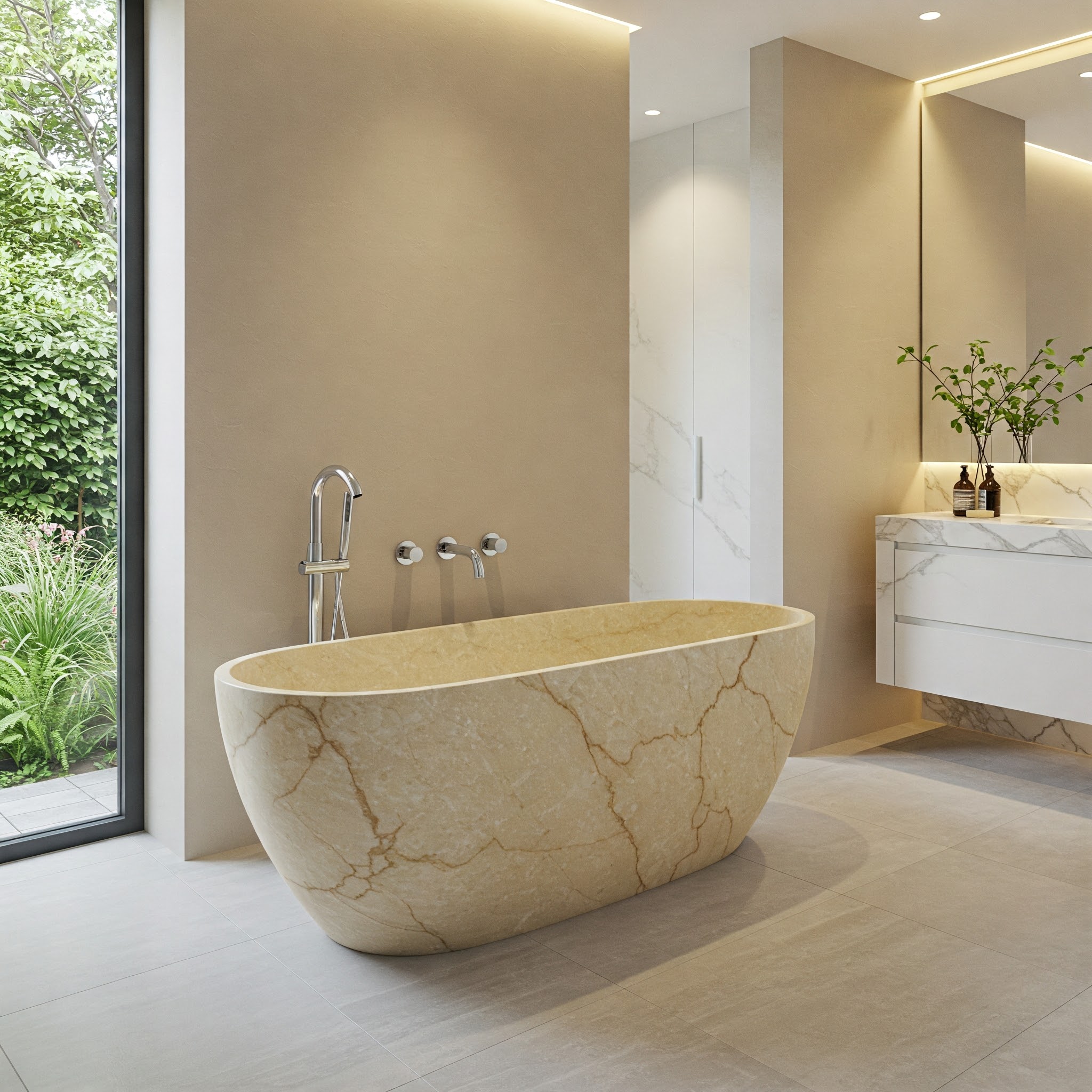The Timeless Appeal of Stone Bathtubs
Have you ever walked into a high-end spa and felt instantly captivated by the centerpiece stone bathtub? There’s something undeniably magical about these natural masterpieces that instantly elevates any bathroom from ordinary to extraordinary. As a homeowner looking to create a personal sanctuary, investing in a stone bathtub might be the ultimate statement of luxury you’ve been searching for.
In recent years, the stone bathtub trend has gained tremendous popularity, particularly among homeowners seeking to create spa-like experiences within their own homes. Furthermore, this ancient bathing vessel has successfully transitioned into modern design, offering a perfect blend of timeless appeal and contemporary aesthetics.
The stone bathtub represents more than just a bathing fixture; it embodies a lifestyle choice that prioritizes wellness, relaxation, and natural beauty. Throughout this comprehensive guide, we’ll explore everything you need to know about these magnificent bathroom centerpieces, from their various types and materials to maintenance tips and top product recommendations.
What Exactly Is a Stone Bathtub?
A stone bathtub is, quite simply, a bathing vessel carved or formed from natural or engineered stone material. Unlike conventional acrylic, fiberglass, or porcelain tubs, stone bathtubs offer exceptional durability, heat retention, and aesthetic appeal that can transform an ordinary bathroom into a luxury retreat.
These bathtubs have actually been around for thousands of years, with evidence of stone bathing vessels dating back to ancient civilizations including the Romans, Greeks, and various Asian cultures. The modern revival of stone bathtubs combines this rich historical tradition with contemporary design sensibilities and improved manufacturing techniques.
Today’s stone bathtubs come in diverse shapes, sizes, and materials, catering to various design preferences and practical requirements. Additionally, improvements in quarrying, cutting, and finishing techniques have made these once exclusively royal luxuries more accessible to discerning homeowners.
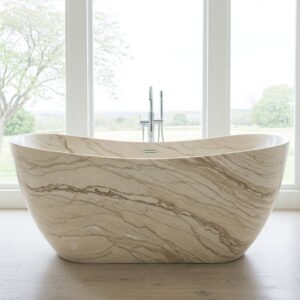
Types of Stone Used for Bathtubs
When exploring stone bathtub options, you’ll encounter several distinct materials, each with unique characteristics, benefits, and considerations. Let’s examine the most popular stone varieties used in bathtub manufacturing:
1. Marble Stone Bathtubs ✅
Marble has long been associated with luxury and remains one of the most sought-after materials for stone bathtubs. This metamorphic rock is known for its distinctive veining patterns that create one-of-a-kind visual interest. Each marble stone bathtub tells its own geological story through these natural patterns.
The natural elegance of marble bathtubs makes them ideal centerpieces in both traditional and contemporary bathrooms. Moreover, marble offers excellent heat retention properties, keeping your bathwater warmer for longer periods compared to many alternative materials.
However, it’s worth noting that marble requires more maintenance than some other stone options. This is because marble is relatively porous and susceptible to staining if not properly sealed and maintained. Regular sealing (typically annually) is necessary to protect your investment.
2. Granite Stone Bathtubs ✅
For those seeking exceptional durability, granite stone bathtubs present an excellent option. This igneous rock is incredibly hard and resistant to scratches, making it one of the most long-lasting bathtub materials available. Furthermore, the natural flecking and crystalline appearance of granite creates visual depth and interest.
Granite’s density also contributes to outstanding heat retention, ensuring your bath stays warm while you relax. Additionally, granite stone bathtubs typically require less maintenance than marble options as they’re naturally less porous and more stain-resistant.
The primary drawback of granite is its weight—these bathtubs are exceptionally heavy and may require floor reinforcement during installation, especially in older homes or upper-floor bathrooms.
3. Travertine Stone Bathtubs ✅
Travertine offers a warm, earthy aesthetic that brings natural elegance to bathroom spaces. This limestone-derived material features distinctive natural pitting and texturing that creates a rustic yet sophisticated appearance. Many homeowners are drawn to travertine’s honey and cream tones that evoke Mediterranean and spa-like atmospheres.
Like other natural stones, travertine provides good heat retention for comfortable bathing experiences. Furthermore, travertine’s natural variations ensure that no two bathtubs are exactly alike, providing truly unique bathroom centerpieces.
On the downside, travertine requires regular maintenance and sealing to prevent staining and water damage. Its natural pores and pits make it more vulnerable to moisture issues if not properly treated and maintained.
4. Onyx Stone Bathtubs ✅
For truly breathtaking visual impact, few materials can match the translucent beauty of onyx stone bathtubs. This semi-precious stone allows light to penetrate its surface, creating dramatic effects when properly illuminated. Many high-end installations incorporate strategic lighting to showcase onyx’s translucent properties.
Beyond its visual appeal, onyx offers good heat retention and a smooth, luxurious feel against the skin. The material’s natural banding and color variations create stunning, one-of-a-kind bathing vessels that serve as artistic focal points.
However, prospective buyers should be aware that onyx requires significant maintenance and care. It’s one of the softer and more porous stone options, making it susceptible to scratching, staining, and damage if not properly treated and maintained.
5. Limestone Stone Bathtubs ✅
Limestone bathtubs provide a softer, more understated aesthetic compared to some of the more dramatic stone options. This sedimentary rock often appears in gentle, neutral tones that complement a wide range of bathroom designs. Additionally, limestone’s fine-grained texture creates a pleasantly smooth bathing surface.
Many homeowners appreciate limestone’s natural warmth and its ability to develop a beautiful patina over time. This quality allows the bathtub to evolve aesthetically, developing character with age and use.
Like other natural stones, limestone requires regular sealing and careful cleaning to prevent staining and etching. Its relatively soft nature (compared to granite, for instance) means it can be more vulnerable to scratching and damage over time.
6. Engineered Stone Bathtubs ✅
For those seeking the aesthetic appeal of natural stone with enhanced durability and lower maintenance requirements, engineered stone bathtubs offer an excellent compromise. These bathtubs are manufactured using crushed natural stone combined with resins and polymers to create a more resilient material.
The primary advantages of engineered stone include improved stain resistance, reduced porosity, and enhanced durability compared to many natural stone options. Additionally, engineered stone typically costs less than solid natural stone alternatives while maintaining a similar appearance.
The main drawback for purists is that engineered stone lacks the complete authenticity and unique character of natural stone. However, for practical everyday use, many homeowners find this a worthwhile trade-off for the reduced maintenance requirements.

Benefits of Choosing a Stone Bathtub
Investing in a stone bathtub involves significant consideration, but the benefits extend far beyond mere aesthetics. Here are the compelling advantages that make stone bathtubs worth considering for your bathroom renovation:
Unmatched Aesthetic Appeal ⭐
There’s simply no denying the visual impact of a stone bathtub. These natural works of art create instant focal points that elevate the entire bathroom’s design. The natural variations in coloration, veining, and texture ensure each stone bathtub is truly one-of-a-kind, essentially providing a functional sculpture for your bathroom.
In addition, stone bathtubs complement virtually any design style, from ultra-modern minimalist spaces to traditional or rustic bathrooms. Their versatility allows them to enhance diverse design visions while maintaining their timeless appeal.
Exceptional Durability 🏆
When properly maintained, stone bathtubs can last for generations—potentially outlasting most other bathroom fixtures. This longevity makes them an investment rather than merely an expense. Furthermore, many natural stones actually develop enhanced character and beauty with age, unlike manufactured materials that typically degrade over time.
The durability of stone also means these bathtubs maintain their value exceptionally well. Should you decide to sell your home in the future, a well-maintained stone bathtub can serve as a significant selling point that distinguishes your property from others on the market.
Superior Heat Retention 🔥
One of the most practical benefits of stone bathtubs is their excellent thermal mass. Put simply, stone absorbs and retains heat effectively, keeping your bathwater warmer for longer periods compared to acrylic or fiberglass alternatives. This natural property enhances the bathing experience significantly, allowing for extended relaxation without constantly adding hot water.
The thermal properties of stone also create a pleasant tactile experience. Unlike the initially cold surface of many bathtub materials, stone gradually warms to touch, providing a more comfortable bathing experience, especially during colder months.
Hygienic Properties 🧼
Many natural stones possess inherent anti-bacterial properties that make them ideal for bathroom applications. Additionally, when properly sealed, stone bathtubs present non-porous surfaces that resist bacterial growth, mold, and mildew—contributing to a healthier bathroom environment.
Unlike some synthetic materials that may contain potentially harmful chemicals, natural stone bathtubs offer a chemical-free bathing experience. This makes them an excellent choice for environmentally conscious homeowners and those with chemical sensitivities.
Eco-Friendly Choice 🌱
For environmentally conscious consumers, stone bathtubs offer significant sustainability advantages. Natural stone is exactly that—natural—requiring less processing and fewer chemical additives than many manufactured alternatives. Additionally, the exceptional longevity of stone means these bathtubs rarely need replacement, reducing waste and resource consumption over time.
Many stone bathtub manufacturers now emphasize responsible quarrying practices and efficient material usage. Some even specialize in reclaimed or repurposed stone, further enhancing the environmental credentials of these beautiful bathroom fixtures.
Top Stone Bathtub Products in 2025
After extensive research and evaluation, I’ve identified some of the finest stone bathtubs currently available on the market. These selections represent diverse styles, materials, and price points to help you find the perfect option for your bathroom renovation project.
1. WOODBRIDGE Solid Surface Freestanding Bathtub
This engineered stone masterpiece combines the beauty of natural marble with enhanced durability and practicality. The WOODBRIDGE Solid Surface Freestanding Bathtub features a seamless one-piece construction with a matte white finish that complements virtually any bathroom design.
Key features include:
- 59″ length, ideal for standard bathrooms
- Non-porous surface resistant to staining and bacteria
- 100% solid surface material (no fiberglass or acrylic layers)
- Includes pre-installed overflow and push-pop-up drain
- 5-year limited warranty
This bathtub strikes an excellent balance between luxury appearance and practical maintenance requirements, making it a bestseller among discerning homeowners.
2. Stone & Beam Marble-Effect Natural Stone Soaking Tub
For those seeking authentic marble beauty, the Stone & Beam Marble-Effect Natural Stone Soaking Tub delivers exceptional craftsmanship and visual impact. This stunning bathtub features genuine Carrara marble with distinctive gray veining that creates a timeless, luxurious aesthetic.
Notable features include:
- 67″ length for spacious bathing comfort
- Hand-finished by skilled artisans
- Naturally cool-to-touch surface that gradually warms
- Available in polished or honed finishes
- Custom drainage options available
While representing a significant investment, this authentic marble bathtub serves as an heirloom-quality centerpiece that will enhance your bathroom for decades.
3. Native Trails Avalon NativeStone Bathtub
Combining eco-friendly materials with contemporary design, the Native Trails Avalon NativeStone Bathtub represents innovative bathroom luxury. This remarkable bathtub is crafted from NativeStone—a proprietary blend of jute fiber and cement that creates a lighter, more resilient alternative to traditional stone.
Standout features include:
- 62″ egg-shaped design with graceful curves
- 40% lighter than conventional concrete
- Naturally insulating for superior heat retention
- Available in four earth-inspired finishes
- Handcrafted by skilled artisans
This eco-conscious option provides the substantial feel and appearance of natural stone with reduced weight and enhanced durability.
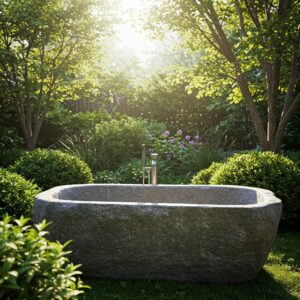
4. Signature Hardware Kateryn Granite Freestanding Tub
The Signature Hardware Kateryn Granite Freestanding Tub showcases the dramatic beauty of black granite in a contemporary oval design. This statement piece combines timeless natural material with modern sculptural form to create a truly breathtaking bathroom focal point.
Key attributes include:
- 72″ length for luxurious bathing space
- Polished exterior with velvet-honed interior finish
- Exceptional heat retention properties
- Includes pre-drilled overflow and drain openings
- Lifetime manufacturer warranty
This granite bathtub represents the pinnacle of natural stone luxury, offering unmatched durability and striking visual presence.
5. Eden Bath Beige Travertine Oval Bathtub
For those drawn to warm, earthy aesthetics, the Eden Bath Beige Travertine Oval Bathtub delivers Mediterranean-inspired elegance. This handcrafted travertine bathtub features natural honey tones that create a welcoming, spa-like atmosphere in any bathroom.
Notable features include:
- 63″ oval design with graceful proportions
- Natural variation in stone coloration and patterning
- Honed interior finish for comfortable bathing
- Exceptional thermal properties
- Includes drain placement recommendations
This travertine masterpiece brings natural warmth and textural interest to bathroom spaces, creating an authentic natural stone experience.
Comparison: Top Stone Bathtubs
| Bathtub Model | Material | Size | Weight | Price Range | Maintenance Level |
|---|---|---|---|---|---|
| WOODBRIDGE Solid Surface | Engineered Stone | 59″ | 125 lbs | $$ | Low |
| Stone & Beam Marble | Natural Marble | 67″ | 900 lbs | $$$$ | High |
| Native Trails Avalon | NativeStone (Jute/Cement) | 62″ | 380 lbs | $$$ | Medium |
| Signature Hardware Kateryn | Granite | 72″ | 1,200 lbs | $$$$ | Medium |
| Eden Bath Beige | Travertine | 63″ | 850 lbs | $$$ | High |
💯 Elevate Your Bathroom Today!
➡ Ready to transform your bathroom into the luxury retreat you deserve? Click on any of our recommended stone bathtubs above to check current pricing and availability on Amazon. These carefully selected options represent the finest stone bathing vessels available, each capable of creating a stunning focal point in your home!
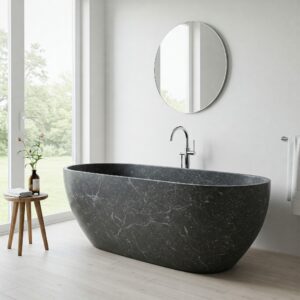
Important Considerations Before Purchasing
Before investing in a stone bathtub, there are several critical factors to consider beyond just the aesthetic appeal. These practical considerations will help ensure you select the right stone bathtub for your specific situation.
Weight and Structural Requirements ⚠️
Stone bathtubs are significantly heavier than conventional bathtubs—often weighing between 500-1,500 pounds empty (and considerably more when filled with water and occupied). Consequently, your bathroom floor must be capable of supporting this substantial weight without compromising structural integrity.
For ground-floor installations on concrete slabs, weight typically presents fewer concerns. However, for upper-floor bathrooms or older homes, professional structural assessment is absolutely essential before installation. In many cases, floor reinforcement may be necessary to safely support a stone bathtub.
It’s also worth considering the logistics of getting the bathtub into your bathroom. These heavy, often one-piece units can present significant transportation and installation challenges, potentially requiring special equipment and multiple installers.
Space and Size Considerations 📏
Stone bathtubs generally command visual attention and physical space. Before selecting a specific model, carefully measure your bathroom to ensure adequate clearance around the tub for comfortable use and cleaning access. Additionally, consider how the bathtub’s proportions will relate to other bathroom fixtures and the overall room scale.
Remember that proper placement enhances both functionality and visual impact. Many designers recommend allowing at least 4-6 inches of clearance around freestanding stone bathtubs to showcase their sculptural qualities and facilitate maintenance.
It’s also important to consider existing plumbing locations and whether modifications will be necessary to accommodate your chosen stone bathtub. Relocating plumbing can add significant cost to your project, so factor this into your planning and budgeting process.
Maintenance Requirements 🧹
While undeniably beautiful, stone bathtubs typically require more maintenance than conventional alternatives. Different stone types have varying maintenance needs, but almost all natural stone bathtubs require:
- Regular cleaning with pH-neutral, non-abrasive cleaners specifically formulated for natural stone
- Periodic resealing (frequency varies by stone type and usage, but typically annually)
- Immediate cleaning of spills, especially acidic substances like vinegar, citrus, or certain cosmetics
- Avoidance of harsh or abrasive cleaning products that can damage the stone or sealant
Before committing to a particular stone type, honestly assess your willingness to perform the necessary maintenance. For those seeking lower maintenance requirements, engineered stone or certain natural stones like granite may provide better options than more porous alternatives like marble or travertine.
Budget Considerations 💰
Stone bathtubs represent a significant investment, with prices ranging from approximately $2,000 for basic engineered stone models to $20,000+ for premium natural stone options. Beyond the initial purchase price, be sure to factor in:
- Shipping costs (which can be substantial due to weight)
- Installation expenses (typically higher than standard bathtub installation)
- Potential structural reinforcement costs
- Specialized plumbing fixtures appropriate for your chosen bathtub
- Long-term maintenance products and potential professional servicing
While the investment is considerable, many homeowners find the value proposition compelling when considering the longevity, beauty, and unique character these bathtubs bring to their homes.
Installation Process and Requirements
Installing a stone bathtub involves more complexity than standard bathroom fixtures. Understanding the process helps ensure proper preparation and successful implementation of your bathroom vision.
Professional Assessment 👷♂️
The installation process should begin with a comprehensive professional assessment of your bathroom space. This evaluation should include:
- Structural analysis to verify floor load capacity
- Measurement confirmation for proper fit and clearance
- Plumbing assessment to determine necessary modifications
- Access evaluation to plan the bathtub’s delivery path
Most reputable stone bathtub suppliers offer consultation services to help determine feasibility and requirements for your specific situation. This preliminary step is invaluable for identifying potential issues before committing to purchase.
Floor Reinforcement (If Necessary) 🏗️
Based on the structural assessment, your floor may require reinforcement to safely support the stone bathtub. This process typically involves:
- Exposing the subfloor and existing support structures
- Adding additional joists, beams, or support columns as needed
- Installing new subfloor material rated for the anticipated load
- Verifying the reinforcement meets local building code requirements
This step requires professional contractors with structural expertise and should never be overlooked or minimized. Proper reinforcement protects both your investment and your home’s structural integrity.
Plumbing Preparations 🔧
Before the bathtub arrives, all necessary plumbing modifications should be completed and verified. This typically includes:
- Installing appropriate water supply lines with sufficient capacity
- Establishing proper drainage with adequate slope
- Incorporating overflow protection as required by local codes
- Installing any specialty fixtures compatible with your stone bathtub
Working with a licensed plumber experienced in high-end bathroom installations will help ensure these technical aspects meet both functional requirements and code compliance.
Delivery and Placement 🚚
The delivery day requires careful planning and usually multiple strong individuals to safely transport and position the bathtub. Key considerations include:
- Clearing a path from delivery vehicle to bathroom location
- Protecting floors, walls, and doorways along the transport route
- Having appropriate equipment (dollies, straps, etc.) ready
- Ensuring sufficient manpower for safe handling
Many suppliers include white-glove delivery service with purchase, coordinating these logistics and providing experienced handlers familiar with moving heavy stone items.
Final Connections and Testing 🚿
Once positioned, the final installation steps include:
- Making water supply and drainage connections
- Installing overflow protection and drain covers
- Applying appropriate sealant around edges as needed
- Testing all functions thoroughly before use
After installation, many professionals recommend waiting 24-48 hours before using the bathtub to allow sealants and adhesives to cure completely.

Maintenance and Care Tips for Stone Bathtubs
Proper maintenance ensures your stone bathtub remains beautiful and functional for generations. Follow these essential care guidelines to protect your investment:
Daily Maintenance 🧽
Establish these simple habits to prevent long-term issues:
- Rinse the bathtub thoroughly after each use to remove soap residue and body oils
- Wipe down with a soft, non-abrasive cloth to remove water droplets and prevent mineral buildup
- Use a squeegee on vertical surfaces to minimize water spots
- Address any spills immediately, especially acidic substances like vinegar, lemon juice, or certain bath products
These daily practices take just moments but significantly extend your bathtub’s beauty and longevity.
Regular Cleaning Routine 🧼
Implement a weekly cleaning regimen using appropriate products:
- Select cleaners specifically formulated for your stone type (look for pH-neutral, non-abrasive formulations)
- Apply cleaner with soft cloths or non-abrasive sponges using gentle circular motions
- Rinse thoroughly with clean water to remove all cleaning product residue
- Dry completely with soft towels to prevent water spotting
Avoid common household cleaners containing acids, ammonia, or abrasive components, as these can damage stone surfaces and sealants. Similarly, never use abrasive scrubbing tools or steel wool on stone bathtubs.
Periodic Sealing 🛡️
Most natural stone bathtubs require regular resealing to maintain their water-resistant properties:
- Marble, limestone, and travertine typically need resealing every 6-12 months
- Granite may require resealing every 1-3 years
- Engineered stone generally needs less frequent sealing (follow manufacturer guidelines)
When applying sealant:
- Ensure the bathtub is completely clean and dry
- Select a high-quality stone sealer appropriate for your specific stone type
- Apply according to manufacturer directions, typically allowing proper absorption time
- Buff away excess sealant to prevent cloudy appearance
- Allow recommended curing time before using the bathtub
Many homeowners schedule professional resealing annually to ensure proper protection and extend their bathtub’s lifespan.
Addressing Common Issues 🔍
Even with proper care, certain issues may arise:
For water spots and mineral deposits:
- Create a paste of baking soda and water
- Gently apply to affected areas with a soft cloth
- Rinse thoroughly and dry completely
For light etching:
- Consult with a stone restoration professional about polishing options
- For minor issues, specific stone polishing products may help
For stains:
- Identify the stain source (organic vs. inorganic) to determine appropriate treatment
- Use poultice treatments specifically formulated for your stone type and stain
- Follow manufacturer directions precisely
- Allow adequate treatment time (often 24-48 hours)
For significant damage or concerns, always consult with stone care professionals rather than attempting aggressive DIY solutions that might cause further harm.

Design Ideas: Incorporating Stone Bathtubs in Different Bathroom Styles
A stone bathtub can enhance virtually any design aesthetic when thoughtfully incorporated. Here are inspiring approaches for various bathroom styles:
Modern Minimalist 🏛️
In contemporary minimalist bathrooms, stone bathtubs provide organic texture and visual weight that balances clean architectural lines:
- Position a geometric stone bathtub as a sculptural centerpiece against a backdrop of large-format porcelain tiles
- Pair with wall-mounted fixtures in matte black or brushed brass for striking contrast
- Keep accessories minimal, allowing the bathtub’s natural beauty to command attention
- Consider subtle integrated lighting to highlight the stone’s texture and characteristics
Modern stone bathtub installations often emphasize the material’s natural properties through thoughtful lighting and spatial arrangement that treats the bathtub as functional art.
Traditional Elegance 🏺
For traditional bathroom designs, stone bathtubs connect with historical bathing traditions while providing timeless luxury:
- Select classic oval or rectangular forms in marble or limestone with detailed pedestal bases
- Complement with traditional faucetry in polished nickel or oil-rubbed bronze
- Incorporate architectural moldings and detailed cabinetry in complementary tones
- Add classic accessories like turned wooden bath caddies and plush Turkish towels
These installations create a sense of established luxury reminiscent of historic European spas and bathhouses.
Nature-Inspired Retreat 🌿
Create a spa-like sanctuary by emphasizing the natural origins of stone:
- Choose river rock, granite, or travertine bathtubs with more organic, less processed appearances
- Incorporate living plants, natural wood elements, and stone flooring for cohesive design
- Install adjacent windows to provide natural light that highlights the stone’s characteristics
- Consider stone in warmer hues (honey travertine, golden limestone) for a welcoming atmosphere
This approach celebrates the bathtub’s connection to the natural world, creating a restorative retreat atmosphere.
Luxe Dramatic Statement 💎
For bold, dramatic bathroom statements:
- Select striking stone varieties like black granite, onyx, or heavily veined marble
- Position centrally in the room, potentially on a raised platform for enhanced visual impact
- Incorporate dramatic lighting from above or below to emphasize the stone’s character
- Pair with precious metals and luxury textiles for complete sensory opulence
These installations treat the bathtub as the unquestionable focal point around which the entire bathroom design revolves.
Transitional Balance ⚖️
For versatile appeal that bridges traditional and contemporary sensibilities:
- Choose clean-lined stone bathtubs with subtle detail elements
- Combine with both contemporary fixtures and classic architectural details
- Use a neutral color palette that highlights the stone’s natural characteristics
- Incorporate mixed metals and diverse textures for visual interest
This approach creates timeless bathrooms that reference both historical precedent and contemporary design sensibilities.
🔥 Transform Your Bathroom Experience Now! 🔥
➡ Don’t wait to create the bathroom sanctuary you’ve always dreamed of! Our carefully researched stone bathtub recommendations represent the perfect balance of luxury, durability, and value. Click any product link to check current pricing and availability—your perfect bathing experience awaits!
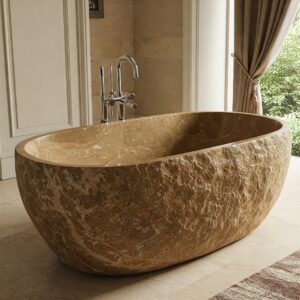
Frequently Asked Questions About Stone Bathtubs
How long do stone bathtubs typically last? ⏳
With proper care and maintenance, stone bathtubs can last for generations—potentially 50+ years for high-quality natural stone options. Many historic examples have survived for centuries, testifying to the exceptional longevity of these bathroom fixtures. This remarkable durability makes stone bathtubs excellent long-term investments compared to conventional bathtubs that typically require replacement every 10-15 years.
The potential lifespan varies somewhat by stone type, with dense materials like granite generally outlasting softer stones like certain limestones. However, all properly maintained stone bathtubs significantly outlast acrylic, fiberglass, and even cast iron alternatives.
Are stone bathtubs comfortable to use? 🛀
Many users report that stone bathtubs provide exceptional bathing comfort due to several factors:
First, stone’s natural heat retention properties create a consistently comfortable bathing temperature. Unlike materials that quickly draw heat from water, stone maintains warmth throughout your bathing experience.
Second, contemporary stone bathtubs feature ergonomic designs with carefully contoured interiors that support the body comfortably. Many include subtle lumbar support and appropriately angled backrests.
Finally, polished stone surfaces feel luxuriously smooth against the skin, enhancing the sensory pleasure of bathing. The substantial feel of stone also creates a sense of security and permanence that many bathers find psychologically comforting.
How do I clean a stone bathtub without damaging it? 🧹
Proper cleaning involves:
- Using only pH-neutral, non-abrasive cleaners specifically formulated for your stone type
- Applying with soft cloths or non-abrasive sponges
- Rinsing thoroughly with clean water
- Drying completely with soft towels
Avoid common bathroom cleaners containing bleach, ammonia, vinegar, or abrasive components, as these can damage stone surfaces and sealants. Similarly, never use abrasive scrubbing tools or steel wool on stone bathtubs.
For routine maintenance, simply rinsing after each use and weekly cleaning with appropriate stone cleaners will maintain your bathtub’s beauty without risking damage.
Can stone bathtubs be repaired if damaged? 🔧
Yes, most stone bathtubs can be professionally restored if damaged. The restoration process varies depending on the type of damage:
For scratches and light etching, professional polishing can often restore the surface completely. This process gradually removes a microscopically thin layer of stone to create a fresh, unmarred surface.
For chips or cracks, stone restoration specialists can use color-matched epoxy fillers that blend seamlessly with the surrounding material. After curing, these repairs can be polished to match the original finish.
For more extensive damage, some stone types can be recut and refinished, though this typically requires removing the bathtub to a workshop environment.
The repairability of stone represents another advantage over many synthetic materials, which often cannot be effectively restored once damaged.
Are there stone bathtub options for smaller bathrooms? 🏠
Absolutely! While many showcase stone bathtubs are large statement pieces, manufacturers recognize the need for more compact options. Consider these possibilities for smaller spaces:
- Japanese-inspired soaking tubs in stone that prioritize depth over length
- Compact oval designs measuring 48-54 inches in length
- Semi-recessed stone bathtubs that conserve floor space
- Corner stone bathtub designs that maximize spatial efficiency
Additionally, some manufacturers offer custom sizing or can create bespoke stone bathtubs tailored to your specific space constraints. These custom options allow homeowners with smaller bathrooms to enjoy stone’s luxury without sacrificing precious square footage.
Conclusion: Is a Stone Bathtub Right for You?
After exploring the world of stone bathtubs, from their diverse materials and benefits to installation considerations and maintenance requirements, you’re now equipped to determine whether these luxury fixtures align with your bathroom vision and lifestyle.
Stone bathtubs undeniably offer exceptional beauty, longevity, and unique character that conventional bathtubs simply cannot match. Their ability to serve as functional art pieces while providing superior bathing experiences makes them compelling options for discerning homeowners.
However, they also represent significant investments—not just financially, but in terms of installation complexity and ongoing maintenance commitment. The weight considerations, potential structural modifications, and regular care requirements demand thoughtful consideration before proceeding.
For those willing to embrace these considerations, a stone bathtub rewards with daily luxury, timeless appeal, and the satisfaction of owning a truly exceptional bathroom centerpiece. These natural masterpieces connect us with ancient bathing traditions while simultaneously creating contemporary sanctuaries for relaxation and rejuvenation.
Whether you’re renovating a primary bathroom, creating a luxury master suite, or designing a spa-inspired retreat, a carefully selected stone bathtub can elevate your project from merely nice to truly extraordinary. The investment pays dividends in daily enjoyment and potential home value enhancement for years to come.
🌟 Ready to Transform Your Bathroom Into a Luxury Retreat? 🌟
➡ Browse our recommended stone bathtubs to find the perfect match for your design vision and practical needs. Each carefully selected option offers exceptional quality and value, representing the finest stone bathing vessels currently available. Click any product link to explore current pricing, availability, and customer reviews!
More FAQ
❓ Is a stone bathtub hard to maintain?
✅ Stone bathtubs require regular sealing and gentle cleaning to preserve their finish, but with proper care, they’re surprisingly easy to maintain and keep looking luxurious…
❓ How heavy is a stone bathtub?
✅ Most stone bathtubs range from 500 to 1,000 pounds or more, depending on size and material, so proper floor reinforcement may be necessary during installation…
❓ What are the benefits of a stone bathtub?
✅ Stone tubs offer excellent heat retention, luxurious aesthetics, and exceptional durability, making them a long-lasting centerpiece for any modern or spa-inspired bathroom…
❓ Do stone bathtubs crack easily?
✅ Natural stone bathtubs are extremely durable and unlikely to crack under normal use, especially when properly installed and sealed against water absorption…
❓ Can a stone bathtub be installed upstairs?
✅ Yes, but installing a stone bathtub upstairs often requires structural assessment and floor reinforcement due to the weight of the tub and water combined…
Recommended for You:
- Fiberglass Bathtub: 15 Essential Expert Tips for Choosing, Installing & Maintaining the Perfect Tub in 2025
- Green Bathtub: 15 Stunning Options For An Eco-Friendly Bathroom Makeover in 2025
- Bathtub Tile Surround: 15 Stunning Ideas to Transform Your Bathroom in 2025
Disclaimer: This article contains affiliate links. If you purchase products through these links, we may earn a small commission at no additional cost to you.

